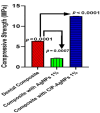Antibacterial Activity of Dental Composite with Ciprofloxacin Loaded Silver Nanoparticles
- PMID: 36364007
- PMCID: PMC9658858
- DOI: 10.3390/molecules27217182
Antibacterial Activity of Dental Composite with Ciprofloxacin Loaded Silver Nanoparticles
Abstract
Resin composites have been widely used in dental restoration. However, polymerization shrinkage and resultant bacterial microleakage are major limitations that may lead to secondary caries. To overcome this, a new type of antibacterial resin composite containing ciprofloxacin-loaded silver nanoparticles (CIP-AgNPs) were synthesized. The chemical reduction approach successfully produced CIP-AgNPs, as demonstrated by FTIR, zeta potential, scanning electron microscopy, and ultraviolet-visible (UV-vis) spectroscopy. CIP-AgNPs were added to resin composites and the antibacterial activity of the dental composite discs were realized against Enterococcus faecalis, Streptococcus mutans, and the Saliva microcosm. The biocompatibility of modified resin composites was assessed and mechanical testing of modified dental composites was also performed. The results indicated that the antibacterial activity and compressive strength of resin composites containing CIP-AgNPs were enhanced compared to the control group. They were also biocompatible when compared to resin composites containing AgNPs. In short, these results established strong ground application for CIP-AgNP-modified dental composite resins.
Keywords: antibacterial activity; ciprofloxacin; dental composite; nanoparticles.
Conflict of interest statement
The authors declare no conflict of interest.
Figures










References
-
- Meereis C.T.W., Münchow E.A., de Oliveira da Silva W.L., da Silva A.F., Piva E. Polymerization shrinkage stress of resin-based dental materials: A systematic review and meta-analyses of composition strategies. J. Mech. Behav. Biomed. Mater. 2018;82:268–281. doi: 10.1016/j.jmbbm.2018.03.019. - DOI - PubMed
-
- Veloso S.R.M., Lemos C.A.A., de Moraes S.L., Vasconcelos B.C.D.E., Pellizzer E.P., Monteiro G.Q.D.M. Clinical performance of bulk-fill and conventional resin composite restorations in posterior teeth: A systematic review and meta-analysis. Clin. Oral Investig. 2018;23:221–233. doi: 10.1007/s00784-018-2429-7. - DOI - PubMed
-
- de Castro Kruly P., Giannini M., Pascotto R.C., Tokubo L.M., Suga U.S.G., de Castro Ruiz Marques A. Meta-analysis of the clinical behavior of posterior direct resin restorations: Low polymerization shrinkage resin in comparison to methacrylate composite resin. PLoS ONE. 2018;13:e0191942. - PMC - PubMed
-
- Pallesen U., Van Dijken J.W.V., Halken J., Hallonsten A.-L., Höigaard R. A prospective 8-year follow-up of posterior resin composite restorations in permanent teeth of children and adolescents in Public Dental Health Service: Reasons for replacement. Clin. Oral Investig. 2013;18:819–827. doi: 10.1007/s00784-013-1052-x. - DOI - PubMed
MeSH terms
Substances
LinkOut - more resources
Full Text Sources

